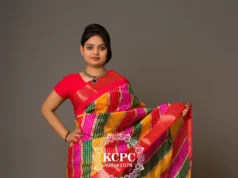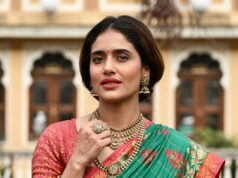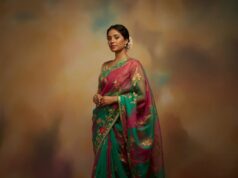- Banarasi Sarees: The Royal Beauty from Varanasi
Banarasi sarees come from the ancient city of Varanasi. These sarees are made of silk and are decorated with gold and silver threads, making them look very rich and grand. People love to wear them at weddings and important ceremonies.
Features of Banarasi Sarees:**
- Silk Fabric: Made from fine silk.
- Zari Work: Has intricate designs in gold and silver.
- Motifs:Includes patterns like flowers, leaves, and architectural designs.
- Kanjeevaram Sarees: The Pride of Tamil Nadu
Kanjeevaram sarees come from Kanchipuram in Tamil Nadu. They are known for their thick, strong silk and bright, vibrant colors. These sarees are often worn by brides and during festivals.
Features of Kanjeevaram Sarees:
- Thick Silk: Made from heavy and durable silk.
- Bold Colors: Comes in bright colors like red, green, and gold.
- Traditional Patterns: Features designs inspired by temples, flowers, and peacocks.
- Chanderi Sarees: The Elegant Choice from Madhya Pradesh
Chanderi sarees come from Chanderi in Madhya Pradesh. They are lightweight and have a shiny finish, making them comfortable to wear. These sarees are perfect for both casual and formal events.
Features of Chanderi Sarees:
- Lightweight Fabric: Made from a mix of silk and cotton.
- Glossy Finish: Has a natural shine.
- Delicate Designs: Includes small and simple patterns.
4. Paithani Sarees: The Jewel of Maharashtra Paithani sarees are from Paithan in Maharashtra. They are known for their bright colors and peacock motifs. These sarees are often made with silk and gold threads, making them look very luxurious.
Features of Paithani Sarees:
– Peacock Motifs: Features beautiful peacock designs.
– Vibrant Colors: Comes in bright colors like magenta, orange, and green.
– Luxurious Fabric: Made from silk and sometimes gold threads.
5. Bandhani Sarees: The Colorful Tradition of Gujarat and Rajasthan Bandhani sarees are made using a tie-dye technique in Gujarat and Rajasthan. They are very colorful and have unique patterns created by tying and dyeing the fabric.
Features of Bandhani Sarees: –
Tie-Dye Technique: Made by tying parts of the fabric and then dyeing it.
– Bright Colors: Comes in various vibrant colors like red, yellow, and blue.
– Unique Patterns: Features designs like dots, waves, and stripes.
6. Patola Sarees: The Double Ikat Wonder from Gujarat Patola sarees come from Patan in Gujarat.
They are made using a special double ikat weaving technique, which creates very detailed and colorful patterns.
These sarees are very expensive because of the complex process involved in making them.
Features of Patola Sarees:
– Double Ikat Weaving: Both the warp and weft threads are dyed before weaving.
– Geometric Patterns: Includes intricate geometric designs. – Vibrant Colors: Known for their bright and contrasting colors.
7. Mysore Silk Sarees: The Smooth Elegance from Karnataka Mysore silk sarees come from Karnataka.
They are made from pure silk and are known for their smooth texture and elegant look. These sarees are often worn at formal occasions and festivals.
Features of Mysore Silk Sarees:
– Pure Silk: Made from high-quality silk.
– Smooth Texture: Very soft and smooth to the touch.
– Simple Elegance: Often features minimalistic designs with rich borders.
8. Pochampally Sarees: The Ikat Heritage of Telangana
Pochampally sarees, also known as Bhoodan Pochampally sarees, come from the town of Pochampally in Telangana. These sarees are known for their beautiful ikat patterns, created through a special dyeing technique.
Features of Pochampally Sarees:
– Ikat Patterns: Created using a special resist-dyeing technique.
– Variety of Fabrics: Available in silk, cotton, and blends.
– Traditional Designs: Features traditional motifs and patterns.
9. Tussar Silk Sarees: The Wild Silk from Bihar and Jharkhand
Tussar silk sarees are made from the silk produced by wild silkworms found in Bihar and Jharkhand. These sarees have a natural golden sheen and rich texture, often featuring tribal and nature-inspired motifs.
Features of Tussar Silk Sarees:
– Natural Golden Sheen: Made from wild silk with a unique golden hue.
– Rich Texture: Known for their textured fabric.
– Tribal Motifs: Often feature designs inspired by nature and tribal art.
10. Assam Silk Sarees: The Pride of the Northeast Assam
silk sarees, including Muga, Eri, and Pat silk, come from Assam. They are known for their durability, natural sheen, and cultural significance. Muga silk sarees, in particular, are highly valued for their golden color and longevity.
Features of Assam Silk Sarees:
– Durable Fabric: Known for their strength and durability.
– Natural Sheen: Offers a unique lustre.
– Cultural Significance: Worn during important cultural and religious events.













[…] Articles: Explore other articles on traditional Indian ceremonies and cultural practices to gain a deeper […]
[…] Different Types of Sarees and Their Regional Significance – Read Now […]